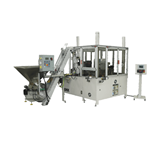Tim Harcourt: The famous Australian poet Dorothea Mackellar seemed to have got it half right when she wrote about the sunburnt country of ‘drought and flooding rains’.
However, in southern Australia at the moment, we seem to be living in a land of drought and more drought, with most of the rainfall falling in bucket loads in the northern half of the continent.
Although the non-farm sector is chugging along quite nicely thanks to the resources boom, there is still concern about the impact of the drought on the rural sector and any further ramifications it may have for the rest of the economy.
There is also concern for the plight of the rural communities themselves because despite the fact Australia is a relatively urbanised country the bush still plays a unique role in our national psyche.
So how bad is the current drought? There’s certainly been a lot of talk about it being ‘the worst drought in a century’ and with climate change issues prominent, the drought has received a lot of media and community attention.
In fact, The Reserve Bank of Australia (RBA) devoted a section of its recent Statement on Monetary Policy to the drought and its economic implication in a historical context.
According to the RBA, when the share of prime agricultural land with a rainfall deficiency this year is compared with previous years the current drought is not as severe as the droughts at the time of federation, in the 1940s, early 1980s, and in 2002.
However, the main difference is the current drought has come so soon after another severe drought in 2002, so there’s been limited recovery time in between for growing conditions to improve and for farmers to store water.
Accordingly, if you examine the Bureau of Meteorology’s five year average data, as the RBA did, you will see that the area of agricultural land recording a rainfall deficiency now is only exceeded by the drought of the 1940s.
In addition, with the steady increase in temperature that the world is now facing, water evaporation is faster which reduces sub-soil moisture. Throw in the El Nino effects and you can see why there is additional concern as it makes it harder for the land to recover even when a drought breaks.
So we know from the Bureau of Meteorology that this is serious stuff. But what do we know about the economic effects? The RBA and most market economists have anticipated that the drought will knock off anywhere between 1/3 to a ½ of a percentage point of GDP growth in the current financial year with some worst case scenarios putting it at a full percentage point.
This is mainly because of the reduction in agricultural supply rather than demand. The RBA expects farm incomes to fall by around 20 per cent in 2006/07 with a smaller fall in livestock production compared the previous drought.
The Australian Bureau of Agricultural and Resource Economics (ABARE) anticipates that most of the reduction in farm output will come from crop production – with big falls in wheat production in New South Wales and Western Australia.
However, a large build-up of inventories will ensure that wheat exports will not fall as much as production. In the case of livestock production, a faster slaughter rate will mean a temporary boost in meat production, although this will mean it will take longer to build up livestock numbers in the next year or so.
According to ABARE, the impact of the build up of stocks, particularly in crops like wheat, may lessen the impact of the drought on rural exports, which can usually shave between 15-25 per cent off rural export values.
In terms of other macroeconomic impacts, there is likely to be a minimal effect on inflation and employment. Macquarie Bank has estimated that the average of the past two droughts suggest that food inflation picks up a just over 1 percentage point adding around 0.2 percentage points to headline inflation.
In addition, as the Australian farm sector is one of the most efficient in the world, and highly capital intensive, the employment implications of the drought are not as bad as they otherwise would be. As a result, rural employment does not always follow rural production. In fact, during the 1994/95 drought there was no fall in employment despite sagging production levels.
So the news is not good although the wider economic impacts are better than could be expected at first glance. There seems to be four things going in our favour.
Firstly, we are experiencing a drought at the same time as a resources boom. Hence, the fall in rural exports, because of drought-related decreases in supply, are coming at the same time as strong growth in resource exports.
Secondly, the rural sector is not as large as it used to be in Australian economic history. According to Commonwealth Bank research, the farm sector accounts for around 3 per cent of total output with a similar share of total national employment, although it still accounts for a fifth of our exports (with over two-thirds of farm sector output currently exported).
Thirdly, the flip-side of the reduction of the farm sector’s share of national economic output and employment is that it has made significant gains in efficiency and productivity. Accordingly, it has been able to survive past droughts as well as sharp swings in exchange rates and commodity prices.
Fourthly, the financial fall-out of the drought has not been as large as it has been in the past. Programmes such as the Farm Management Deposit (FMD) scheme, through altered taxation arrangements, allow farmers to make deposits when earnings are high, so they can draw them down when earnings are low (that is, saving for when it is not a rainy day). Transport subsidies and drought relief schemes are also helping the worse-affected areas.
Fifthly, the economic diversity of rural and regional Australia has helped. Whilst there are obvious knock-on effects for rural businesses who service the farm sector, many regional Australian economies have a range of export-orientated industries that service mining, manufacturing and professional services businesses as well ( a point well made by the ANZ Bank in their analysis of the drought).
As Austrade Agribusiness adviser Robert Sutton said: “Australian rural exporters are having a tough time meeting next year’s demands, as well as export orders. However, there is a lot of interest in emerging markets as well in industries such as biofuels and environmental technologies.”
In conclusion, the drought is only having a minimal impact on output, inflation and employment but with a significant impact on rural exports. Fortunately, there is significant momentum in the overall Australian economy to carry us through the worst effects of the drought.
But there’s doubt that the drought is making it tough for our farmers and other fellow Australians in the bush. Fortunately, the overall efficiency of the farm sector and its past resilience means it can bounce back but better weather conditions and improved market access in world trade would certainly make a difference.
- Suppliers
- New to IndustrySearch? Book a Demo
- Advertise with us
- Login
- Email Marketing
- Buyers
- Get Quotes
- Articles & Ideas
- Login
- Subscribe to newsletter
- My Details
- Get Quotes
- Automation & Control
- Automotive Workshop Equipment
- Cleaning Equipment
- Construction & Heavy Machinery
- Conveyor Systems & Components
- Cranes & Hoists
- Electrical & Power Generation Equipment
- Electronic Components
- Farming & Agriculture
- Food & Beverage Processing
- Forklifts & Attachments
- Hydraulic & Pneumatic Equipment
- Industrial Materials, Tools & Components
- Industrial Pumps
- IT Hardware & Industrial Computing
- IT Software & Applications
- Laboratory Equipment & Instruments
- Manufacturing & Industrial Equipment
- Material Handling & Lifting
- Metalworking & Machining
- Mining Equipment & Machinery
- Packaging & Labelling Machinery
- Pallet Management
- Personal Protective Equipment
- Security & Surveillance
- Test & Measurement
- Transport Equipment
- Trucks & Trailers
- Warehouse Storage & Racking
- Waste & Environmental Management
- Welding Machines & Accessories
- Woodworking & Joinery Machines
- Workplace Equipment
- Workplace Safety Equipment
- Get Quotes
- Automation & Control
- Automotive Workshop Equipment
- Cleaning Equipment
- Construction & Heavy Machinery
- Conveyor Systems & Components
- Cranes & Hoists
- Electrical & Power Generation Equipment
- Electronic Components
- Farming & Agriculture
- Food & Beverage Processing
- Forklifts & Attachments
- Hydraulic & Pneumatic Equipment
- Industrial Materials, Tools & Components
- Industrial Pumps
- IT Hardware & Industrial Computing
- IT Software & Applications
- Laboratory Equipment & Instruments
- Manufacturing & Industrial Equipment
- Material Handling & Lifting
- Metalworking & Machining
- Mining Equipment & Machinery
- Packaging & Labelling Machinery
- Pallet Management
- Personal Protective Equipment
- Security & Surveillance
- Test & Measurement
- Transport Equipment
- Trucks & Trailers
- Warehouse Storage & Racking
- Waste & Environmental Management
- Welding Machines & Accessories
- Woodworking & Joinery Machines
- Workplace Equipment
- Workplace Safety Equipment
Trusted by 1.4 million Australian industrial buyers
Buyers
- Discover products & solutions
- Login
- Subscribe To Newsletter
- Browse All Products
- Read Articles
Suppliers
Advertise
- Promote your products & solutions
- New to IndustrySearch? Book a Demo
- Login / Forgot Password
- Advertise Your Products
- Success Stories
- Email Marketing
- Suppliers
- Advertise with us
- Login
- Email Marketing
- Buyers
- Get Quotes
- Articles & Ideas
- Login
- Subscribe to newsletter
- My Details
Get Quotes
- Automation & Control
- Automotive Workshop Equipment
- Cleaning Equipment
- Construction & Heavy Machinery
- Conveyor Systems & Components
- Cranes & Hoists
- Electrical & Power Generation Equipment
- Electronic Components
- Farming & Agriculture
- Food & Beverage Processing
- Forklifts & Attachments
- Hydraulic & Pneumatic Equipment
- Industrial Materials, Tools & Components
- Industrial Pumps
- IT Hardware & Industrial Computing
- IT Software & Applications
- Laboratory Equipment & Instruments
- Manufacturing & Industrial Equipment
- Material Handling & Lifting
- Metalworking & Machining
- Mining Equipment & Machinery
- Packaging & Labelling Machinery
- Pallet Management
- Personal Protective Equipment
- Security & Surveillance
- Test & Measurement
- Transport Equipment
- Trucks & Trailers
- Warehouse Storage & Racking
- Waste & Environmental Management
- Welding Machines & Accessories
- Woodworking & Joinery Machines
- Workplace Equipment
- Workplace Safety Equipment
Get Quotes
- Automation & Control
- Automotive Workshop Equipment
- Cleaning Equipment
- Construction & Heavy Machinery
- Conveyor Systems & Components
- Cranes & Hoists
- Electrical & Power Generation Equipment
- Electronic Components
- Farming & Agriculture
- Food & Beverage Processing
- Forklifts & Attachments
- Hydraulic & Pneumatic Equipment
- Industrial Materials, Tools & Components
- Industrial Pumps
- IT Hardware & Industrial Computing
- IT Software & Applications
- Laboratory Equipment & Instruments
- Manufacturing & Industrial Equipment
- Material Handling & Lifting
- Metalworking & Machining
- Mining Equipment & Machinery
- Packaging & Labelling Machinery
- Pallet Management
- Personal Protective Equipment
- Security & Surveillance
- Test & Measurement
- Transport Equipment
- Trucks & Trailers
- Warehouse Storage & Racking
- Waste & Environmental Management
- Welding Machines & Accessories
- Woodworking & Joinery Machines
- Workplace Equipment
- Workplace Safety Equipment
Trusted by 1.4 million Australian industrial buyers


-160x160-state_article-rel-cat.png)









